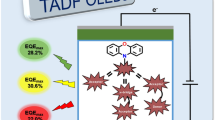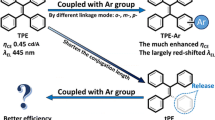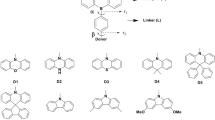Abstract
The realization of both thermally activated delayed fluorescence (TADF) and room-temperature phosphorescence (RTP) from a single molecule is highly advantageous for efficient light-emitting diodes (LEDs). In this work, we have studied a donor core-substituted pyromellitic diimide (CzPhPmDI) derivative which shows both RTP and TADF. Apart from CzPhPmDI, we have studied heavy atom-substituted (on both donor and acceptor) CzPhPmDI and methyl-substituted spacer for improved RTP and TADF emissions. In the optimized geometry of CzPhPmDI, phenyl spacer is not completely perpendicular to both donor and acceptor, and dihedral angle is nearly 600. From the dihedral angle-dependent studies of excited state property, we have found that a gradual increment of dihedral angle (more perpendicular to both Cz and PmDI) leads to lowering of singlet–triplet (ΔEST) gap initially, but later it further increases the singlet–triplet gap (spacer is nearly perpendicular). With Me substitution on spacer (in CzMe2PhPmDI), the spacer becomes perpendicular to both Cz and PmDI groups. The increased ΔEST can be attributed to different excitation natures of S1 and T1. Further investigation suggests that it leads to the formation of a twisted intramolecular charge transfer (TICT) state with increased coplanarity of the spacer with both the Cz and PmDI unit, which eventually leads to TADF with redshifted bright emission. While heavy atom substitution on donor does not influence the excited state characteristics, Br substitution on PmDI increases the spin–orbit coupling strength leading to improved intersystem and reverse intersystem crossing, which is beneficial for efficient RTP and TADF.





Similar content being viewed by others
References
Nakanotani H, Higuchi T, Furukawa T, Masui K, Morimoto K, Numata M, Tanaka H, Sagara Y, Yasuda T, Adachi C (2014) High-efficiency organic light-emitting diodes with fluorescent emitters. Nat Commun 5:4016
Wong MY, Zysman-Colman E (2017) Purely organic thermally activated delayed fluorescence materials for organic light-emitting diodes. Adv Mater 29:1605444
Tao Y, Yuan K, Chen T, Xu P, Li H, Chen R, Zheng C, Zhang L, Huang W (2014) Thermally activated delayed fluorescence materials towards the breakthrough of organoelectronics. Adv Mater 26:7931–7958
Yang Z, Mao Z, Xie Z, Zhang Y, Liu S, Zhao J, Xu J, Chi Z, Aldred MP (2017) Recent advances in organic thermally activated delayed fluorescence materials. Chem Soc Rev 46:915–1016
Xu S, Chen R, Zheng C, Huang W (2016) Excited state modulation for organic afterglow: materials and applications. Adv Mater 28:9920–9940
Chen H, Xing X, Miao J, Zhao C, Zhu M, Bai J, He Y, Meng H (2020) Highly efficient flexible organic light emitting transistor based on high-K polymer gate dielectric. Adv Opt Mater 8:1901651
dos Santos PL, Etherington MK, Monkman AP (2018) Chemical and conformational control of the energy gaps involved in the thermally activated delayed fluorescence mechanism. J Mater Chem C 6:4842–4853
Liu Y, Li C, Ren Z, Yan S, Bryce MR (2018) All-organic thermally activated delayed fluorescence materials for organic light-emitting diodes. Nat Rev Mater 3:18020
Pal AK, Bhattacharyya K, Datta A (2020) Polymorphism dependent 9-phosphoanthracene derivative exhibiting thermally activated delayed fluorescence: a computational investigation. J Phys Chem A 124:11025–11037
Yuan WZ et al (2010) Crystallization-induced phosphorescence of pure organic luminogens at room temperature. J Phys Chem C 114:6090–6099
Bolton O, Lee K, Kim H-J, Lin KY, Kim J (2011) Activating efficient phosphorescence from purely organic materials by crystal design. Nat Chem 3:205–210
Wu H, Chi W, Chen Z, Liu G, Gu L, Bindra AK, Yang G, Liu X, Zhao Y (2019) Room temperature phosphorescence: achieving amorphous ultralong room temperature phosphorescence by Coassembling planar small organic molecules with polyvinyl alcohol. Adv Funct Mater 29:1970063
Kuila S, George SJ (2020) Phosphorescence energy transfer: ambient afterglow fluorescence from water-processable and purely organic dyes via delayed sensitization. Angew Chem Int Ed 59:9393–9397
Yang J et al (2018) The influence of the molecular packing on the room temperature phosphorescence of purely organic luminogens. Nat Commun 9:840
Goudappagouda, Manthanath A, Wakchaure VC, Ranjeesh KC, Das T, Vanka K, Nakanishi T, Babu SS (2019) Paintable room-temperature phosphorescent liquid formulations of alkylated bromonaphthalimide. Angew Chem Int Ed 58:2284–2288
Zhang T, Ma X, Wu H, Zhu L, Zhao Y, Tian H (2020) Molecular engineering for metal-free amorphous materials with room-temperature phosphorescence. Angew Chem Int Ed 59:11206–11216
El-Sayed MA (1963) Spin—orbit coupling and the radiationless processes in nitrogen heterocyclics. J Chem Phys 38:2834–2838
Ventura B, Bertocco A, Braga D, Catalano L, d’Agostino S, Grepioni F, Taddei P (2014) Luminescence properties of 1,8-naphthalimide derivatives in solution, in their crystals, and in co-crystals: toward room-temperature phosphorescence from organic materials. J Phys Chem C 118:18646–18658
Garain S, Kuila S, Garain BC, Kataria M, Borah A, Pati SK, George SJJACIE (2021) Arylene diimide phosphors: aggregation modulated twin room temperature phosphorescence from pyromellitic diimides. Angew Chem Int Ed Engl 60:12323–12327
Kuila S, Rao KV, Garain S, Samanta PK, Das S, Pati SK, Eswaramoorthy M, George SJ (2018) Aqueous phase phosphorescence: ambient triplet harvesting of purely organic phosphors via supramolecular scaffolding. Angew Chem Int Ed 57:17115–17119
Kuila S, Garain S, Banappanavar G, Garain BC, Kabra D, Pati SK, George SJ (2021) Ambient room temperature phosphorescence and thermally activated delayed fluorescence from a core-substituted pyromellitic diimide derivative. J Phys Chem B 125:4520–4526
Sasaki S, Drummen GPC, Konishi G-I (2016) Recent advances in twisted intramolecular charge transfer (Tict) fluorescence and related phenomena in materials chemistry. J Mater Chem C 4:2731–2743
Sun X-W, Peng L-Y, Gao Y-J, Fang Q, Cui G (2022) Thermally activated delayed fluorescence of a pyromellitic diimide derivative in the film environment investigated by combined Qm/Mm and Ms-Caspt2 methods. J Phys Chem A 126:4176–4184
Becke AD (1993) Density-functional thermochemistry. Iii. The role of exact exchange. J Chem Phys 98:5648–5652
Lee C, Yang W, Parr RG (1988) Development of the Colle-Salvetti correlation-energy formula into a functional of the electron density. Phys Rev B 37:785–789
Yanai T, Tew DP, Handy NC (2004) A new hybrid exchange-correlation functional using the coulomb-attenuating method (Cam-B3lyp). Chem Phys Lett 393:51–57
Zhao Y, Truhlar DG (2008) The M06 suite of density functionals for main group thermochemistry, thermochemical kinetics, noncovalent interactions, excited states, and transition elements: two new functionals and systematic testing of four M06-class functionals and 12 other functionals. Theoret Chem Acc 120:215–241
Chai J-D, Head-Gordon M (2008) Systematic optimization of long-range corrected hybrid density functionals. J Chem Phys 128:084106
Alipour M, Fallahzadeh P (2016) First principles optimally tuned range-separated density functional theory for prediction of phosphorus-hydrogen spin–spin coupling constants. Phys Chem Chem Phys 18:18431–18440
Scalmani G, Frisch MJ (2010) Continuous surface charge polarizable continuum models of solvation. I. General formalism. J Chem Phys 132:114110
Martin RL (2003) Natural transition orbitals. J Chem Phys 118:4775–4777
Frisch MJ et al (2016) Gaussian 16 Rev. C.01, Wallingford, CT
van Lenthe E, Snijders JG, Baerends EJ (1996) The zero-order regular approximation for relativistic effects: the effect of spin-orbit coupling in closed shell molecules. J Chem Phys 105:6505–6516
van Lenthe E, van Leeuwen R, Baerends EJ, Snijders JG (1996) Relativistic regular two-component hamiltonians. Int J Quantum Chem 57:281–293
Wang F, Ziegler T (2005) A simplified relativistic time-dependent density-functional theory formalism for the calculations of excitation energies including spin-orbit coupling effect. J Chem Phys 123:154102
te Velde G, Bickelhaupt FM, Baerends EJ, Fonseca Guerra C, van Gisbergen SJA, Snijders JG, Ziegler T (2001) Chemistry with Adf. J Comput Chem 22:931–967
Lawetz V, Orlandi G, Siebrand W (1972) Theory of intersystem crossing in aromatic hydrocarbons. J Chem Phys 56:4058–4072
Robinson GW, Frosch RP (1963) Electronic excitation transfer and relaxation. J Chem Phys 38:1187–1203
Beljonne D, Shuai Z, Pourtois G, Bredas JL (2001) Spin−orbit coupling and intersystem crossing in conjugated polymers: a configuration interaction description. J Phys Chem A 105:3899–3907
Ou Q, Subotnik JE (2013) Electronic relaxation in benzaldehyde evaluated via Td-Dft and localized diabatization: intersystem crossings, conical intersections, and phosphorescence. J Phys Chem C 117:19839–19849
Samanta PK, English NJ (2020) Triplet harvesting using two-photon absorption in substituted naphthalimides for their application as heavy-atom-free photosensitizers. J Phys Chem C 124:8178–8185
Garain BC, Samanta PK, Pati SK (2021) Intersystem crossing in boron-based donor–spiro–acceptor organic chromophore: a detailed theoretical study. J Phys Chem A 125:6674–6680
Acknowledgements
B.C.G. expresses gratitude to the Council for Scientific and Industrial Research (CSIR), New Delhi, for providing a Senior Research Fellowship (SRF). The National Supercomputing Mission (NSM), through its Paramyukti Clusters and home cluster TITAN, is to be thanked by B.C.G. and S.K.P. for providing us with the computational capability. The J. C. Bose Fellowship, Department of Science and Technology (DST), Government of India, is gratefully acknowledged by S.K.P. for research assistance.
Funding
This study was supported by Science and Engineering Research Board, India, (Grant No. SERB/SKP/4703).
Author information
Authors and Affiliations
Contributions
The BCG is a graduate student, who did all the computational studies. Then both the corresponding author and the BCG wrote the manuscript after long discussions and modified in several iterations to produce this final manuscript.
Corresponding author
Ethics declarations
Conflict of interests
The authors declare no competing financial interest.
Additional information
Publisher's Note
Springer Nature remains neutral with regard to jurisdictional claims in published maps and institutional affiliations.
Supplementary Information
Below is the link to the electronic supplementary material.
Rights and permissions
Springer Nature or its licensor (e.g. a society or other partner) holds exclusive rights to this article under a publishing agreement with the author(s) or other rightsholder(s); author self-archiving of the accepted manuscript version of this article is solely governed by the terms of such publishing agreement and applicable law.
About this article
Cite this article
Garain, B.C., Pati, S.K. Tailoring dual emissions from pyromellitic diimide derivatives through substitution: a theoretical perspective. Theor Chem Acc 142, 70 (2023). https://doi.org/10.1007/s00214-023-03003-x
Received:
Accepted:
Published:
DOI: https://doi.org/10.1007/s00214-023-03003-x




